Blended and flipped teaching approaches have been implemented in a numerical methods course taken by undergraduate mechanical engineering students at USF. With flipped instruction, students practice and demonstrate skills in class and come prepared to do so by viewing or reading content beforehand. Blended instruction is slightly more general and aims to optimally integrate online and face-to-face learning. During the spring 2014 semester, a blended approach was used; in the summer 2014 term, both blended and flipped approaches were used. Eight particular multiple-choice questions on the final exam were based on topics taught in a flipped mode in the summer and in a blended mode in the spring; these questions were otherwise identical.
 Image: Courtesy of University of Washington
Image: Courtesy of University of Washington
Six other questions were based on topics taught in a blended mode in both terms. When analyzed for various demographic segments of the student population, such as females, under-represented groups, or transfer status, there were statistically significant improvements from the spring to the summer term in the outcome of the eight questions but not in the outcome of the six questions. This suggests that flipped instruction may be the better approach for increasing achievement in numerical methods.

Photo: Discussing flipped vs blended at the EnFuse Symposium, Washington DC, April 27-29, 2016.
Other dependent variables were analyzed, including a numerical methods self-efficacy score and the free-response outcome on the final, and although not statistically significant, there was typically an upward change from the spring to the summer term for the various demographic segments considered. This suggests that the introduction of flipped instruction may lead to enhanced outcomes. Students were asked to rate the classroom environment using the College and University Classroom Environment Inventory (CUCEI). Although statistical differences were not found between the semesters, the students favored the spring classroom on some dimensions and the summer classroom on others.
Based on a student evaluation of the summer term’s flipped component, 30% of the respondents preferred the flipped instruction, with another 40% unsure of their preferences. However, over half of the students preferred using class time for active learning with the instructor present versus listening to a lecture. Interestingly, the respondents’ sentiments were predominantly neutral to negative concerning the influence of the flipped classroom in providing future-career experience as well as greater learning gains. Yet, in an open-ended question, the most frequently-stated benefits of flipped instruction were related to preparedness, engagement, and professional behaviors as well as enhanced or deeper learning.
Related Conference Papers and News
R. Clark, A. Kaw, M. Besterfield-Sacre, A. Scott, “How Do you Like your Course – Semi-Flipped or Flipped?”, ASEE Conference Proceedings, Seattle, WA, June 2015.
